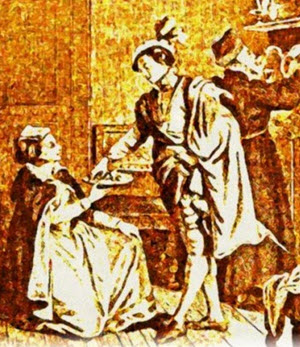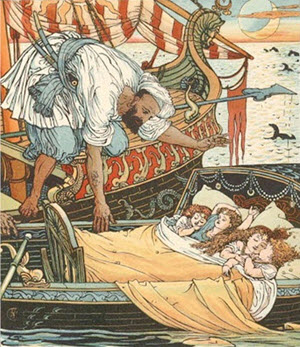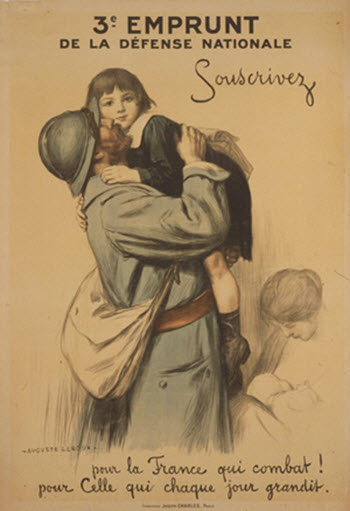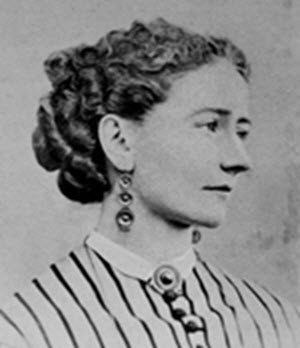Home > Secret Rooms and Hiding Places > >
Chapter: [1] [2] [3] [4] [5] [6] [7] [8] [9] [10] [11] [12] [13] [14] [15] [16] [17]
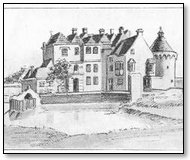
COMPTON WINYATES, WARWICKSHIRE
Clever Hiding Places
Of all the ancient mansions in the United Kingdom, and there is still, happily, a large selection, none perhaps is so picturesque and quaintly original in its architecture as the secluded Warwickshire house Compton Winyates. The general impression of its vast complication of gable ends and twisted chimneys is that some enchanted palace has found its way out of one of the fairy-tale books of our early youth and concealed itself deep down in a sequestered hollow among the woods and hills. We say concealed itself, for indeed it is no easy matter to find it, for anything in the shape of a road seems rather to lead away from, than to it; indeed, there is no direct road from anywhere, and if we are fortunate enough to alight upon a footpath, that also in a very short time fades away into oblivion! So solitary also is the valley in which the mansion lies and so shut in with thick clustering trees, that one unacquainted with the locality might pass within fifty yards of it over and over again without observing a trace of it. When, however, we do discover the beautiful old structure, we are well repaid for what trouble we may have encountered. To locate the spot within a couple of miles, we may state that Brailes is its nearest village; the nearest town is Banbury, some nine miles away to the east.
Perhaps if we were to analyse the peculiar charm this venerable pile conveys, we should find that it is the wonderful colour, the harmonies of greys and greens and reds which pervade its countless chimney clusters and curious step-gables. We will be content, however, with the fascinating results, no matter how accomplished, without inquiring into the why and wherefore; and pondering over the possibilities of the marvellous in such a building see, if the interior can carry out such a supposition.
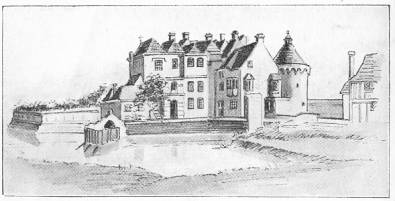
SCOTNEY HALL, SUSSEX
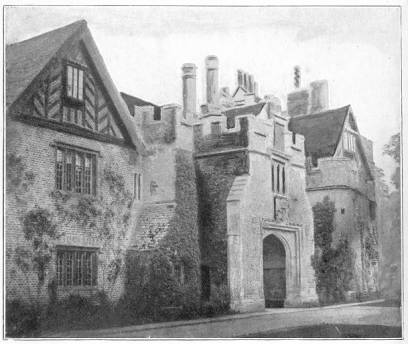
COMPTON WINYATES, WARWICKSHIRE
Wending our way to the top of the house, past countless old-world rooms and corridors, we soon discover evidences of the days of priest-hunting. A "Protestant" chapel is on the ground floor (with a grotesquely carved screen of great beauty), but up in the roof we discover another—a "Popish" chapel. From this there are numerous ways of escape, by staircases and passages leading in all directions, for even in the almost impenetrable seclusion of this house the profoundest secrecy was necessary for those who wished to celebrate the rites of the forbidden religion. Should the priest be surprised and not have time to descend one of the many staircases and effect his escape by the ready means in the lower part of the house, there are secret closets between the timber beams of the roof and the wainscot into which he could creep.
Curious rooms run along each side in the roof round the quadrangle, called "the barracks," into which it would be possible to pack away a whole regiment of soldiers. Not far away are "the false floors," a typical Amy Robsart death-trap!
A place of security here, once upon a time, could only be reached by a ladder; later, however, it was made easier of access by a dark passage, but it was as secure as ever from intrusion. The fugitive had the ready means of isolating himself by removing a large portion of the floor-boards; supposing, therefore, his lurking-place had been traced, he had only to arrange this deadly gap, and his pursuers would run headlong to their fate.
Many other strange rooms there are, not the least interesting of which is a tiny apartment away from everywhere called "the Devil's chamber," and another little chamber whose window is invariably found open in the morning, though securely fastened on the previous night!
Various finds have been made from time to time at Compton Winyates. Not many years ago a bricked-up space was found in a wall containing a perfect skeleton!—at another an antique box full of papers belonging to the past history of the family (the Comptons) was discovered in a secret cavity beneath one of the windows.
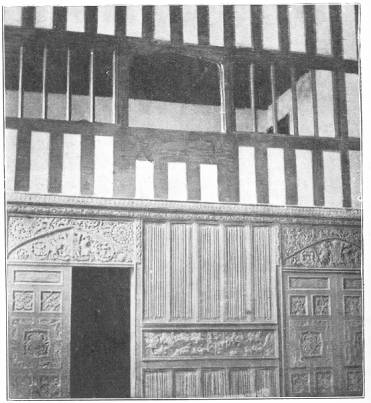
MINSTREL'S GALLERY, COMPTON WINYATES
The "false floors" to which we have alluded suggests a hiding-place that was put to very practical use by two old maiden ladies some years ago at an ancient building near Malvern, Pickersleigh Court. Each night before retiring to rest some floor-boards of a passage, originally the entrance to a "priest's hole," were removed. This passage led to their bedroom, so that they were protected much in the same way as the fugitive at Compton Winyates, by a yawning gap. Local tradition does not record how many would-be burglars were trapped in this way, but it is certain that should anyone ever have ventured along that passage, they would have been precipitated with more speed than ceremony into a cellar below. Pickersleigh, it may be pointed out, is erroneously shown in connection with the wanderings of Charles II. after the battle Worcester.[1]
[Footnote 1: See The Flight of the King.]
Salford Prior Hall (otherwise known as "the Nunnery," or Abbots Salford), not far from Evesham, is another mansion remarkable for its picturesqueness as well as for its capacity for hiding. It not only has its Roman Catholic chapel, but a resident priest holds services there to this day. Up in the garret is the "priest's hole," ready, it would seem, for some present emergency, so well is it concealed and in such perfect working order; and even when its position is pointed out, nothing is to be seen but the most innocent-looking of cupboards. By removing a hidden peg, however, the whole back of it, shelves and all, swings backwards into a dismal recess some four feet in depth. This deceitful swing door may be secured on the inside by a stout wooden bolt provided for that purpose.
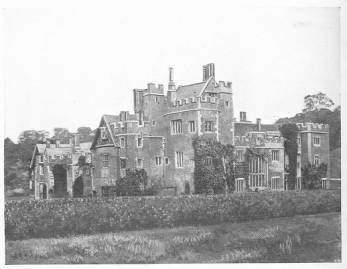
COMPTON WINYATES, WARWICKSHIRE
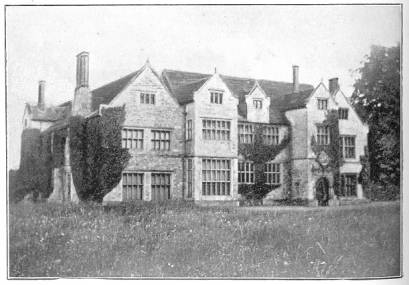
SAWSTON HALL, CAMBRIDGESHIRE
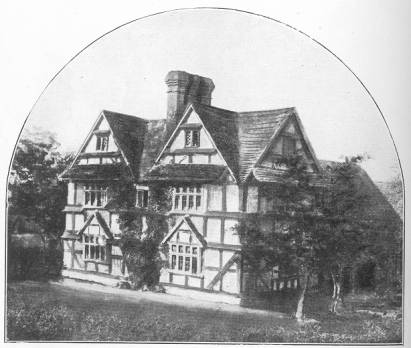
PICKERSLEIGH COURT, WORCESTERSHIRE
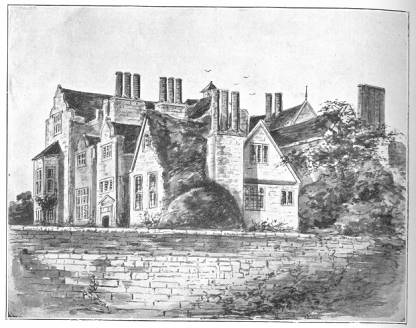
SALFORD PRIOR HALL, WARWICKSHIRE
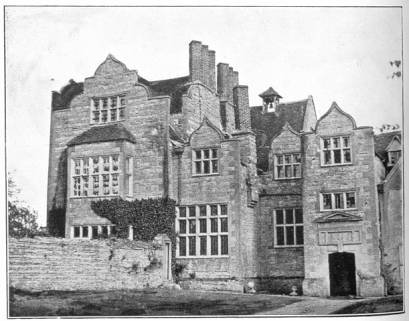
SALFORD PRIOR HALL
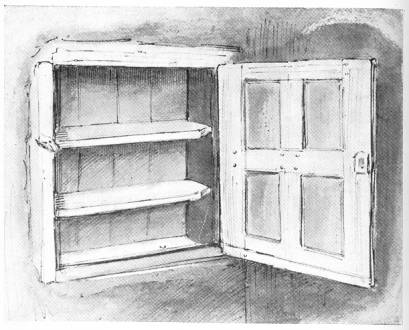
HIDING-PLACE, SALFORD PRIOR
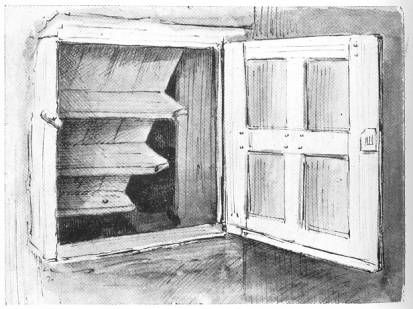
HIDING-PLACE, SALFORD PRIOR (SHEWING ENTRANCE)
Another hiding place as artfully contrived and as little changed since the day it was manufactured is one at Sawston, the ancestral seat of the old family of Huddleston. Sawston Hall is a typical Elizabethan building. The one which preceded it was burnt to the ground by the adherents of Lady Jane Grey, as the Huddleston of that day, upon the death of King Edward VI., received his sister Mary under his protection, and contrived her escape to Framlingham Castle, where she was carried in disguise, riding pillion behind a servant.
The secret chamber, as at Harvington, is on the top landing of the staircase, and the entrance is so cleverly arranged that it slants into the masonry of a circular tower without showing the least perceptible sign from the exterior of a space capable of holding a baby, far less a man. A particular board in the landing is raised, and beneath it, in a corner of the cavity, is found a stone slab containing a circular aperture, something after the manner of our modern urban receptacles for coal. From this hole a tunnel slants downwards at an angle into the adjacent wall, where there is an apartment some twelve feet in depth, and wide enough to contain half a dozen people—that is to say, not bulky ones, for the circular entrance is far from large. Blocks of oak fixed upon the inside of the movable floor-board fit with great nicety into their firm oak sockets in the beams, which run at right angles and support the landing, so that the opening is so massive and firm that, unless pointed out, the particular floor-board could never be detected, and when secured from the inside would defy a battering-ram.
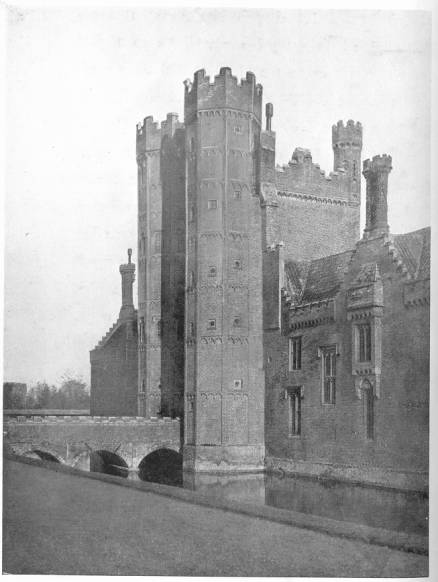
OXBURGH HALL, NORFOLK
The Huddlestons, or rather their connections the Thornboroughs, have an old house at Leyburn, in Yorkshire, named "The Grove," which also contained its hiding-place, but unfortunately this is one of those instances where alterations and modern conveniences have destroyed what can never be replaced. The priest, Father John Huddleston (who aided King Charles II. to escape, and who, it will be remembered, was introduced to that monarch's death-bed by way of a secret staircase in the palace of Whitehall), lived in this house some time during the seventeenth century.
One of the most ingenious hiding-places extant is to be seen at Oxburgh Hall, near Stoke Ferry, the grand old moated mansion of the ancient Bedingfield family. In solidity and compactness it is unique. Up in one of the turrets of the entrance gateway is a tiny closet, the floor of which is composed of brickwork fixed into a wooden frame. Upon pressure being applied to one side of this floor, the opposite side heaves up with a groan at its own weight. Beneath lies a hollow, seven feet square, where a priest might lie concealed with the gratifying knowledge that, however the ponderous trap-door be hammered from above, there would be no tell-tale hollowness as a response. Having bolted himself in, he might to all intents and purposes be imbedded in a rock (though truly a toad so situated is not always safe from intrusion). Three centuries have rolled away and thirteen sovereigns have reigned since the construction of this hiding-place, but the mechanism of this masterpiece of ingenuity remains as perfect as if it had been made yesterday! Those who may be privileged with permission to inspect the interesting hall will find other surprises where least expected. An oak-panelled passage upon the basement of the aforesaid entrance gateway contains a secret door that gives admittance into the living-rooms in the most eccentric manner.
A priest's hole beneath the floor of a small oratory adjoining "the chapel" (now a bedroom) at Borwick Hall, Lancashire, has an opening devised much in the same fashion as that at Oxburgh. By leaning his weight upon a certain portion of the boards, a fugitive could slide into a convenient gap, while the floor would adjust itself above his head and leave no trace of his where-abouts.
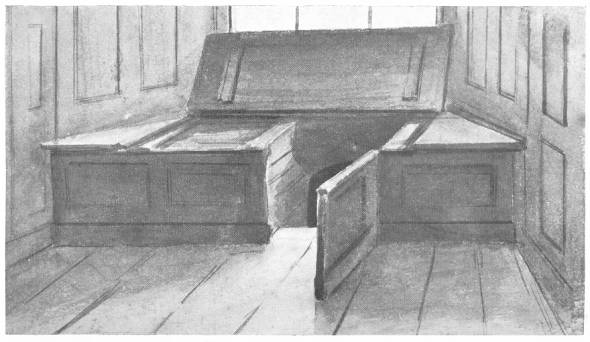
ENTRANCE TO HIDING-PLACE, PARHAM HALL, SUSSEX
Window-seats not uncommonly formed the entrance to holes beneath the level of the floor. In the long gallery of Parham Hall, Sussex, an example of this may be seen. It is not far from "the chapel," and the officiating priest in this instance would withdraw a panel whose position is now occupied by a door; but the entrance to the hiding-place within the projecting bay of the window is much the same as it ever was. After the failure of the Babington conspiracy one Charles Paget was concealed here for some days.
The Tudor house of Tusmore, in Oxfordshire, also had a secret chamber, approached through a fixed settle in "the parlour" window. A tradition in the neighbourhood says that the great fish-pond near the site of the old house was dug by a priest and his servant in the days of religious persecution, constituting their daily occupation for twelve years!
Paxhill, in Sussex, the ancient seat of the Bordes, has a priest's hole behind a window-shutter, and it is large enough to hold several persons; there is another large hiding-hole in the ceiling of a room on the ground floor, which is reached through a trap-door in the floor above. It is provided with a stone bench.
In castles and even ecclesiastical buildings sections of massive stone columns have been found to rotate and reveal a hole in an adjacent wall—even an altar has occasionally been put to use for concealing purposes. At Naworth Castle, for instance, in "Lord William's Tower," there is an oratory behind the altar, in which fugitives not only could be hidden but could see anything that transpired in its vicinity. In Chichester Cathedral there is a room called Lollards' Prison, which is approached by a sliding panel in the old consistory-room situated over the south porch. The manor house of Great Chalfield, in Wiltshire, has a unique device by which any suspected person could be watched. The eye of a stone mask in the masonry is hollowed out and through this a suspicious lord of the manor could, unseen, be a witness to any treachery on the part of his retainers or guests.
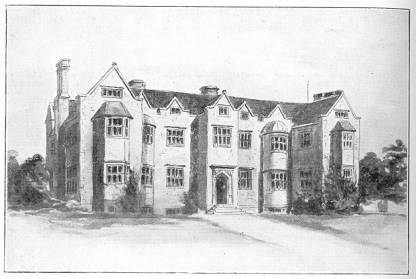
PAXHILL, SUSSEX
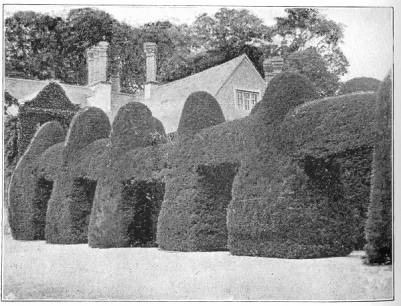
CLEEVE PRIOR MANOR HOUSE, WORCESTERSHIRE
The old moated hall Baddesley Clinton, in Warwickshire, the ancient seat of the Ferrers, has a stone well or shaft near "the chapel." There were formerly projections or steps by which a fugitive could reach a secret passage extending round nearly two sides of the house to a small water-gate by the moat, where a boat was kept in readiness. Adjoining the "banqueting-room" on the east side of the building is a secret chamber six feet square with a bench all round it. It is now walled up, but the narrow staircase, behind the wainscoting, leading up to it is unaltered.
Cleeve Prior Manor House, in Worcestershire (though close upon the border of Warwickshire)) famous for its unique yew avenue, has a priest's hole, a cramped space five feet by two, in which it is necessary to lie down. As at Ingatestone, it is below the floor of a small chamber adjoining the principal bedroom, and is entered by removing one of the floor-boards.
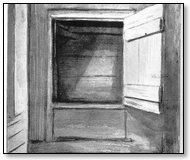
Hidden Rooms
Wollas Hall, an Elizabethan mansion on Bredon Hill, near Pershore (held uninterruptedly by the Hanford family since the sixteenth century), has a chapel in the upper part of the house, and a secret chamber, or priest's hole, provided with a diminutive fire-place. When the officiating priest was about to celebrate Mass, it was the custom here to spread linen upon the hedges as a sign to those in the adjacent villages who wished to attend.
A hiding-place at Treago, Herefordshire (an unique specimen of a thirteenth-century fortified mansion) inhabited by the Mynor family for more than four hundred years), has quite luxurious accommodation—a sleeping-place and a reading-desk. It is called "Pope's Hole." The walls on the south-east side of the house are of immense thickness, and there are many indications of secret passages within them.
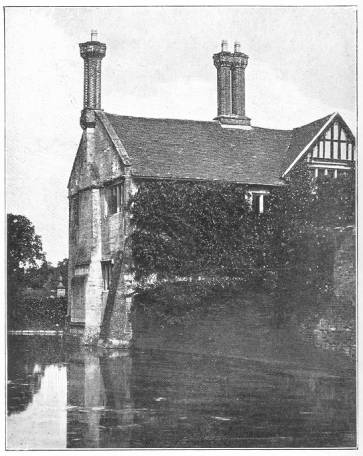
BADDESLEY CLINTON, WARWICKSHIRE
Some fifty years ago a hiding-hole was opened in a chimney adjoining "the chapel" of Lydiate Hall, Lancashire; and since then one was discovered behind the rafters of the roof. Another ancient house close by contained a priest's hole where were found some religious books and an old carved oak chair.
Myddleton Lodge, near Ilkley, had a secret chapel in the roof, which is now divided up into several apartments. In the grounds is to be seen a curious maze of thickly planted evergreens in the shape of a cross. From the fact that at one end remain three wooden crosses, there is but little doubt that at the time of religious persecution the privacy of the maze was used for secret worship.
When Slindon House, Sussex, was undergoing some restorations, a "priest's hole" communicating with the roof was discovered. It contained some ancient devotional books, and against the walls were hung stout leathern straps, by which a person could let himself down.
The internal arrangements at Plowden Hall, Shropshire, give one a good idea of the feeling of insecurity that must have been so prevalent in those "good old days." Running from the top of the house there is in the thickness of the wall, a concealed circular shoot about a couple of feet in diameter, through which a person could lower himself, if necessary, to the ground floor by the aid of a rope. Here also, beneath the floor-boards of a cupboard in one of the bedrooms, is a concealed chamber with a fixed shelf, presumably provided to act as a sort of table for the unfortunate individual who was forced to occupy the narrow limits of the room. Years before this hiding-place was opened to the light of day (in the course of some alterations to the house), its existence and actual position was well known; still, strange to say, the way into it had never been discovered.

